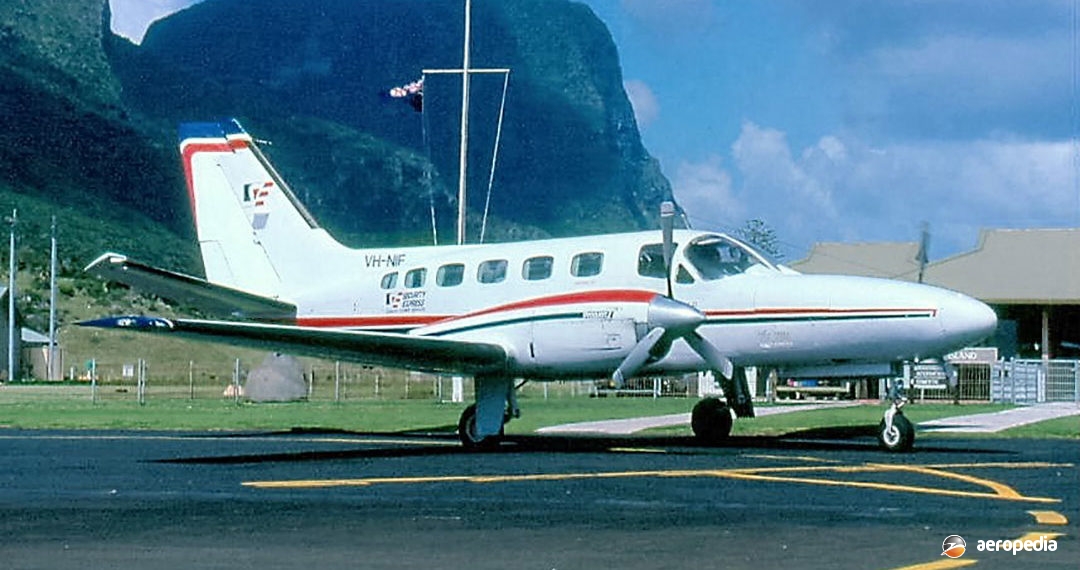Photograph:
Cessna 441 Conquest VH-NIF (c/n 441-0232) visiting Lord Howe Island in September 1989 (David C Eyre)
Country of origin:
United States of America
Description:
Light business and executive aircraft
Power Plant:
Two 466 kw (625 shp) Garrett AiResearch TPE 331-8-401S turboprops
Specifications:
- Wingspan: 15.04 m (49 ft 4 in)
- Length: 11.89 m (39 ft 0¼ in)
- Height: 4.01 m (13 ft 1¾ in)
- Wing area: 23.56 m² (253.6 sq ft)
- Max speed at 4,875 m (16,000 ft): 545 km/h (338 mph)
- Max cruising speed at 5,485 m (18,000 ft): 534 km/h (332 mph)
- Economical cruising speed: 456 km/h (283 mph)
- Initial rate of climb: 742 m/min (2,435 ft/min)
- Service ceiling: 11,280 m (37,000 ft)
- Range with eight passengers and 45 mins reserve at 10,060 m (33,000 ft) at max cruising speed: 3,566 km (1,595 miles)
- Range at economical cruising speed at 10,060 m (33,000 ft): 2,626 km (1,632 miles)
- Empty weight: 2,489 kg (5,487 lb)
- Loaded weight: 4,468 kg (9,850 lb)
History:
The first turboprop business aircraft added to the Cessna range, the Cessna 441 Conquest, was designed as an intermediate-sized aircraft between the Company’s piston-engine twins and the turbofan-power Citation series. The prototype flew for the first time on 26 August 1975, and the first production machine was delivered on 24 September 1977. By 1979 production averaged ten aircraft per month.
Following test flying with the prototype, a number of changes were made to the design before it entered production. The prototype was fitted with Garrett AiResearch TPE 331-8-251 engines, but the Garrett AiResearch TPE 331-8-401S engines, which had a maximum output of 645 kw (865 shp), de-rated to 466 kw (625 shp) in the Conquest, were fitted on production machines. Power of 466 kw (625 shp) was constant up to a height of 4,877 m (16,000 ft).
However, the principal change in the production aircraft was the 0.92 m (3 ft) increase in the wingspan. This increased the aspect ratio to 9.5 to 1 and provided extra fuel capacity, so that some 1,771 litres (390 Imp gals) could be carried. Accommodation was provided for two-side-by-side on the flight deck, and a maximum of nine passengers in the cabin. A Cessna Conquest II was fitted with Pratt & Whitney PT6A engines and became known as the Cessna 435 but did not enter production. After the Cessna 425 Corsair was re-named the Conquest I, the aircraft which up to then had been the Cessna Conquest, became known as the Conquest II.
The first Conquest seen in this region arrived late in 1979 and became VH-KDJ (c/n 441-0070) with National Homes of Brisbane, QLD. However, shortly after, the type was grounded for six months due to a couple of accidents involving the type in the USA. The elevator trim-tab actuator was subsequently re-designed, production resumed, and deliveries re-commenced. VH-KDJ was exported to the United States in April 1990.
The next Conquest imported was VH-KDN (c/n 441-0130) for Rex Aviation, the then NSW Cessna distributor, later becoming VH-XMG in October 1998. The type became quite popular in this region, and more than 35 examples of the Conquest series have been registered in Australia over the years.
In August 2008 the Cessna 441 Conquest series was grounded due to an airframe limit warning. Up to that time they were regarded as a reliable and robust aircraft, serving their operators well, but the 34 Cessna Conquest turbine aircraft on the Australian Civil Aircraft Register at that time were grounded. Cessna imposed a 22,500 hour limit on the type because of possible cracking in the airframe and the manufacturer withdrew all support for aircraft which had reached that limit. The Australian Civil Aviation Safety Authority (CASA) issued an Airworthiness Directive (AD) related to the aircraft. At that time only six aircraft were affected, these being one operated by O’Connor Airlines and five by Jetcraft, but as aircraft reached their limit they were grounded.

